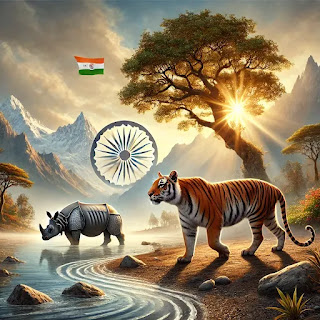Climate Change: A Silent Threat to India's Endangered Wildlife
How Climate Change is Pushing India’s Endangered Animals to the Brink
Climate change is no longer a distant threat—it is happening now, and its effects are becoming increasingly evident in India’s diverse ecosystems. From the soaring Himalayas to the dense Western Ghats, rising temperatures, erratic weather patterns, and habitat degradation are driving many endangered species closer to extinction. India, home to a rich biodiversity and numerous endemic species, is witnessing alarming changes that threaten its fragile wildlife.
1. The Royal Bengal Tiger (Panthera tigris tigris)
The Sundarbans, a UNESCO World Heritage site and the largest mangrove forest in the world, is home to the iconic Royal Bengal Tiger. However, rising sea levels due to climate change threaten to submerge large portions of this unique ecosystem. With the increasing frequency of cyclones and saline intrusion into freshwater sources, the tiger’s habitat is shrinking, forcing them into human-dominated landscapes, leading to greater human-wildlife conflict.
2. The Snow Leopard (Panthera uncia)
Snow leopards, the “ghosts of the mountains,” are highly adapted to the cold, rugged terrains of the Himalayas. However, rising global temperatures are causing their high-altitude habitat to warm, reducing the range of alpine zones they depend on. This leads to competition with other species migrating upwards and forces snow leopards into closer proximity with human settlements, increasing instances of retaliatory killings by herders.
3. The Indian Pangolin (Manis crassicaudata)
Pangolins, one of the most trafficked mammals in the world, are already under immense pressure due to poaching. Climate change exacerbates their plight by disrupting their primary food source—ants and termites. Erratic monsoon patterns and extreme droughts affect soil moisture levels, making it difficult for pangolins to forage, further endangering their populations.
4. The One-Horned Rhinoceros (Rhinoceros unicornis)
Kaziranga National Park, the stronghold of the one-horned rhinoceros, faces increasing threats from climate-induced flooding. The Brahmaputra River, which nourishes the park’s rich biodiversity, is experiencing more frequent and severe floods, leading to habitat loss and the drowning of rhinos. Rising water levels also push these animals towards human settlements, increasing conflicts and poaching risks.
5. The Great Indian Bustard (Ardeotis nigriceps)
One of the rarest birds in the world, the Great Indian Bustard is on the brink of extinction, with fewer than 150 individuals remaining. Climate change-induced desertification and erratic rainfall patterns in Rajasthan and Gujarat have led to habitat degradation. Additionally, increased temperatures disrupt their breeding cycles, making recovery efforts even more challenging.
6. The Malabar Civet (Viverra civettina)
An elusive and critically endangered species endemic to the Western Ghats, the Malabar civet is facing a rapid decline due to habitat destruction. Climate change is intensifying deforestation and altering monsoon patterns, further fragmenting its already limited range.
7. The Olive Ridley Turtle (Lepidochelys olivacea)
India’s coasts, especially Odisha, are crucial nesting grounds for Olive Ridley turtles. Rising sea levels and coastal erosion threaten these nesting beaches, disrupting their reproductive cycle. Warmer temperatures also skew the sex ratio of hatchlings, as higher temperatures result in more females than males, affecting population stability in the long run.
What Can Be Done?
While the effects of climate change on India’s endangered species are severe, concerted efforts can help mitigate these impacts. Conservation strategies must include:
Strengthening protected areas and wildlife corridors to allow species to migrate and adapt.
Restoring degraded habitats and increasing afforestation efforts.
Implementing climate-resilient conservation policies and involving local communities in wildlife protection.
Enhancing research and monitoring efforts to understand climate change’s impact on wildlife and develop adaptive strategies.
Reducing carbon emissions and advocating for stronger climate action to address the root cause of these threats.
India’s endangered wildlife is facing an unprecedented crisis due to climate change. As temperatures rise and ecosystems shift, it is our responsibility to take immediate action. Conservation efforts must not only focus on protecting individual species but also on preserving the delicate balance of entire ecosystems. The fight against climate change is not just about saving wildlife—it is about safeguarding the future of our planet.
By raising awareness, supporting conservation initiatives, and advocating for stronger climate policies, we can ensure that India’s rich biodiversity continues to thrive for generations to come.



Comments
Post a Comment